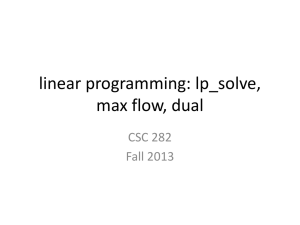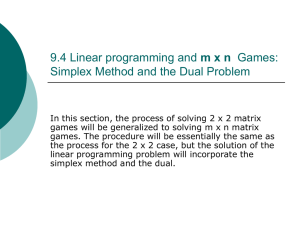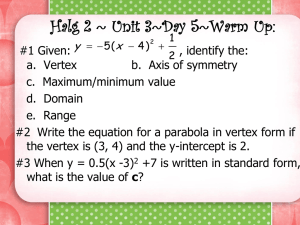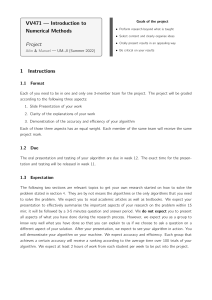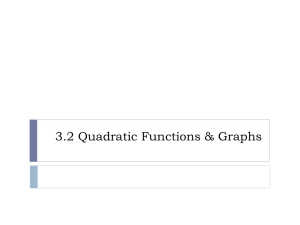Dynamic Multi-Terabit Core Optical Network
advertisement
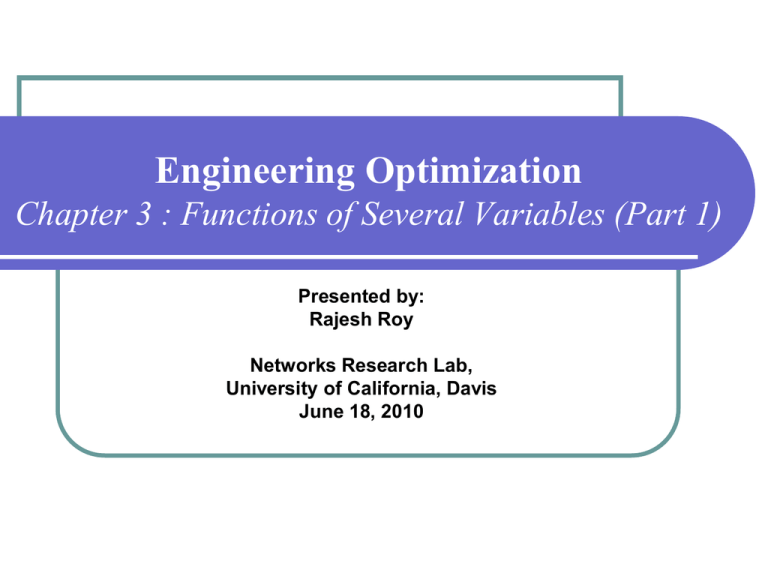
Engineering Optimization Chapter 3 : Functions of Several Variables (Part 1) Presented by: Rajesh Roy Networks Research Lab, University of California, Davis June 18, 2010 Introduction x is a vector of design variables of dimension N No constraints on x ƒ is a scalar objective function ƒ and its derivatives exist and are continuous everywhere We will be satisfied to identify local optima x* Static Question Dynamic Question Test candidate points to see whether they are (or are not) minima, maxima, saddlepoints, or none of the above. Given x(0), a point that does not satisfy the above-mentioned optimality criteria, what is a better estimate x(1) of the solution x*? Introduction The nonlinear objective ƒ will typically not be convex and therefore will be multimodal. Example: Optimality Criteria We examine optimality criteria for basically two reasons: (1) because they are necessary to recognize solutions (2) because they provide motivation for most of the useful methods Consider the Taylor expansion of a function of several variables: Necessary and Sufficient Conditions Necessary Conditions: Sufficient Conditions: Static Question: Example Dynamic Question : Searching x* The methods can be classified into three broad categories: 1. Direct-search methods, which use only function values The S2 (Simplex Search) Method Hooke–Jeeves Pattern Search Method Powell’s Conjugate Direction Method 2. Gradient methods, which require estimates of the first derivative of ƒ(x) Cauchy’s Method 3. Second-order methods, which require estimates of the first and second derivatives of ƒ(x) Newton’s Method ……. Motivation behind different methods: Available computer storage is limited Function evaluations are very time consuming Great accuracy in the final solution is desired Sometimes its either impossible or else very time consuming to obtain analytical expressions for derivatives The S2 (Simplex Search) Method 1. Set up a regular simplex* in the space of the independent variables and evaluate the function at each vertex. 2. The vertex with highest functional value is located. 3. This ‘‘worst’’ vertex is then reflected through the centroid to generate a new point, which is used to complete the next simplex 4. Jump to Step 2 if the performance index decreases smoothly Reflection: Suppose x(j) is the point to be reflected. Then the centroid of the remaining N points is All points on the line from x( j) through xc are given by New Vertex Point: *In N dimensions, a regular simplex is a polyhedron composed of N+1 equidistant points, which form its vertices. Hooke-Jeeves Pattern Search Method Exploratory Moves: 1. Given a specified step size the exploration proceeds from an initial point by the specified step size in each coordinate direction. 2. If the function value does not increase, the step is considered successful. 3. Otherwise, the step is retracted and replaced by a step in the opposite direction, which in turn is retained depending upon whether it succeeds or fails. Pattern Moves: 1. Single step from the present base point along the line from the previous to the current base point. Hooke-Jeeves Pattern Search Method Hooke-Jeeves Pattern Search Method Example: Powell’s Conjugate Direction Method Given a quadratic function q(x), two arbitrary but distinct points x(1) and x(2), and a direction d, if y(1) is the solution to min q(x(1), d) and y(2) is the solution to min q(x(2), d), then the direction y(2)–y(1) is C conjugate to d. Theorem : If a quadratic function in N variables can be transformed so that it is just the sum of perfect squares, then the optimum can be found after exactly N single-variable searches, one with respect to each of the transformed variables. Gradient-Based Methods All of the methods considered here employ a similar iteration procedure: Cauchy’s Method Taylor expansion of the objective about x: The greatest negative scalar product results from the choice This is the motivation for the simple gradient method: Example: Newton’s Method Consider again the Taylor expansion of the objective: We form a quadratic approximation to ƒ(x) by dropping terms of order 3 forcing x(k1), the next point in the sequence, to be a point where the gradient of the approximation is zero. Therefore, So according to Newton’s optimization method:
